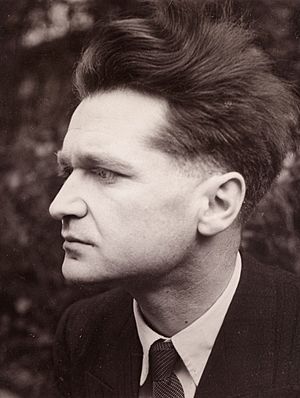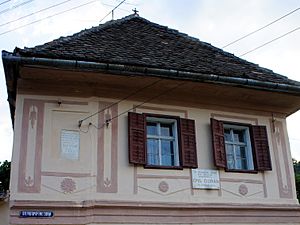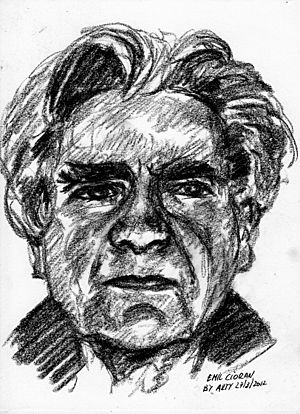Emil Cioran facts for kids
Quick facts for kids
Emil Cioran
|
|
|---|---|

Cioran in Romania, around 1947
|
|
| Born |
Emil Mihai Cioran
8 April 1911 Resinár, Austria-Hungary (Today Rășinari, Romania)
|
| Died | 20 June 1995 (aged 84) Paris, France
|
| Nationality | Romanian; stateless after 1948, when Romania became a communist country |
| Alma mater | |
| Partner(s) | Simone Boué |
| Awards |
|
| Region | Western philosophy
|
| School |
|
|
Main interests
|
aesthetics, antinatalism, ethics, hagiography, literary criticism, music, nihilism, poetry, religion |
|
Influences
|
|
| Signature | |
 |
|
Emil Mihai Cioran (born April 8, 1911 – died June 20, 1995) was a Romanian thinker, writer of short sayings (called aphorisms), and essayist. He wrote books in both Romanian and French. His writings are known for their strong sense of philosophical pessimism, which means he often focused on the difficult parts of life. He also had a unique writing style and used many aphorisms. Cioran's works often explored ideas about suffering, decline, and nihilism (the belief that life has no meaning). In 1937, Cioran moved to Paris, France, where he lived quietly with his partner, Simone Boué, until he passed away in 1995. After 1948, when Romania became a communist country, he became stateless, meaning he no longer belonged to any country.
Contents
Early Life and Education
Emil Cioran was born in Resinár, which is now Rășinari, Romania. His father, Emilian Cioran, was an Orthodox priest, and his mother, Elvira, led a Christian women's group.
When he was 10, Cioran moved to Sibiu for school. At 17, he started studying literature and philosophy at the University of Bucharest. There, he became friends with famous writers like Eugène Ionesco and Mircea Eliade. He also studied with important Romanian thinkers like Constantin Noica and Petre Țuțea.
Cioran learned German at a young age, which allowed him to read many philosophy books not available in Romanian. In his teenage years, he read works by thinkers such as Friedrich Nietzsche, Arthur Schopenhauer, and Fyodor Dostoevsky. He became an agnostic, someone who believes we cannot know if God exists. He often thought about "the trouble of existence." At the university, he was influenced by philosophers like Georg Simmel and Martin Heidegger. He was also inspired by the Russian philosopher Lev Shestov, who believed that life can be random and unpredictable.
From the age of 20, Cioran began to suffer from insomnia, a condition where he couldn't sleep well. This problem lasted his whole life and greatly influenced his writing. His first book, On the Heights of Despair, was inspired by his experiences with insomnia.
Career and Views
Studies in Berlin
In 1933, Cioran received a scholarship to study at the University of Berlin. There, he learned about many famous philosophers, including Immanuel Kant and Friedrich Nietzsche. While in Berlin, he became interested in the political ideas of the time, including those of the Nazi regime. He even wrote articles expressing support for leaders like Adolf Hitler.
However, Cioran later deeply regretted these early political views. He described his support for such ideas as "the worst mistake of my youth." He said that if he was cured of any bad idea, it was certainly that one.
First Books in Romania
Cioran's first book, On the Heights of Despair, was published in Romania in 1934. It won an award for young writers. Despite its success, Cioran later said it was "a very poorly written book."
He published several other books in Romanian, including The Book of Delusions (1935) and The Transfiguration of Romania (1936). His book Tears and Saints (1937) was not well received. His mother even asked him to take it back because it caused her embarrassment.
During this time, Cioran also showed interest in the Iron Guard, a nationalist group in Romania. Although he was never a member, he supported some of their ideas for a while. However, he later strongly rejected these nationalist and extremist views. In the 1990s, he heavily changed his book The Transfiguration of Romania, removing parts he considered extreme or "pretentious and stupid." He explained that he learned what it means to be carried away by a movement without truly believing in it, and that he became "immune" to such ideas.
Life and Writing in France
After returning from Berlin, Cioran taught philosophy for a year in Brașov, Romania. In 1937, he moved to Paris with a scholarship. After a short visit to Romania between 1940 and 1941, Cioran never went back. During this last period in Romania, he had a closer connection with the Iron Guard, which had gained power. He even gave a radio speech praising their former leader.
However, Cioran later completely rejected his support for the Iron Guard and their nationalist ideas. He often expressed regret for his involvement. He called it "a complex of movements; more than this, a demented sect and a party."
Cioran started writing The Passionate Handbook in 1940, finishing it by 1945. This was the last book he wrote in Romanian. From then on, he published all his books in French.
In 1942, Cioran met Simone Boué, who also suffered from insomnia. They lived together for the rest of his life. Cioran kept their relationship very private and never wrote or spoke about it publicly.
In 1949, his first French book, A Short History of Decay, was published. It won an award for the best book by a non-French author. Throughout his life, Cioran often refused literary prizes he was offered.
Later Life and Legacy
Cioran lived most of his life quietly in the Latin Quarter of Paris. He avoided public attention but stayed in touch with many friends, including Mircea Eliade and Samuel Beckett.
In 1995, Cioran passed away from Alzheimer's disease and was buried in the Montparnasse Cemetery in Paris.
After his partner, Simone Boué, died, many of Cioran's handwritten notes (over 30 notebooks) were found. These were later bought by a Romanian businessman for a large sum of money.
Cioran's life has inspired plays, such as A Paris Loft with a View on Death by Matei Vișniec. In 2009, the Romanian Academy made Cioran a member after his death.
Under the rule of Nicolae Ceaușescu in Romania, Cioran's works were not allowed. In 1974, a book of his was banned in Spain for being "atheist, blasphemous, and anti-Christian." Cioran found this ban amusing.
Major Themes and Style
Cioran wasn't very interested in traditional philosophy when he was young. Instead, he preferred to write about his own thoughts and feelings. He once said, "I invented nothing. I've been the one and only secretary of my own sensations."
Many of Cioran's books are made up of aphorisms, which are short, clever sayings. For example, his book The Trouble with Being Born is entirely written in aphorisms.
A key idea in all his works is Philosophical pessimism. This means he often focused on the negative or difficult aspects of life. However, his pessimism was also unique and sometimes even joyful. It wasn't just a simple sadness.
His writings often show a feeling of struggle, which Cioran himself experienced. His books, especially those written in Romanian, are very emotional and sometimes express strong feelings. He explored the idea of human alienation, which is the feeling of being disconnected from the world or others. In 1932, he wrote, "Is it possible that existence is our exile and nothingness our home?"
Cioran's works also cover many other topics: ideas about original sin, the sad parts of history, the end of civilizations, and the refusal to find comfort in faith. He was fascinated by history and read many writers who explored the idea of "decline." He believed that as long as people stayed connected to their roots, they could avoid decline. But he felt that modern society was moving towards its own destruction through too much self-analysis and artificial achievements.
Regarding God, Cioran famously said that "without Bach, God would be a complete second-rate figure." He also believed that "Bach's music is the only argument proving the creation of the Universe cannot be regarded as a complete failure." Cioran felt that great artists like Bach, Shakespeare, and Dostoevsky offered strong reasons to question the idea of a single God.
Cioran became most famous for writing in French, even though it was a language he found difficult at first. A famous French poet once called him "the greatest French writer to honor our language" since another well-known writer had passed away.
Major Works
In Romanian
- Pe culmile disperării (translated "On the Heights of Despair"), 1934
- Cartea amăgirilor ("The Book of Delusions"), 1936
- Schimbarea la față a României ("The Transfiguration of Romania"), 1936
- Lacrimi și Sfinți ("Tears and Saints"), 1937
- Îndreptar pătimaș ("The Passionate Handbook"), 1991
In French
All of Cioran's major works in French have been translated into English by Richard Howard.
- Précis de décomposition ("A Short History of Decay"), 1949
- Syllogismes de l'amertume (tr. "All Gall Is Divided"), 1952
- La Tentation d'exister ("The Temptation to Exist"), 1956
- Histoire et utopie ("History and Utopia"), 1960
- La Chute dans le temps ("The Fall into Time"), 1964
- Le Mauvais démiurge (literally The Evil Demiurge; tr. "The New Gods"), 1969
- De l'inconvénient d'être né ("The Trouble with Being Born"), 1973
- Écartèlement (tr. "Drawn and Quartered"), 1979
- Exercices d'admiration 1986, and Aveux et anathèmes 1987 (tr. and grouped as "Anathemas and Admirations")
- Œuvres (Collected works), 1995
- Mon pays/Țara mea ("My country", written in French, first published in Romania in a bilingual volume), 1996
- Cahiers 1957–1972 ("Notebooks"), 1997
See also
 In Spanish: Emil Cioran para niños
In Spanish: Emil Cioran para niños




